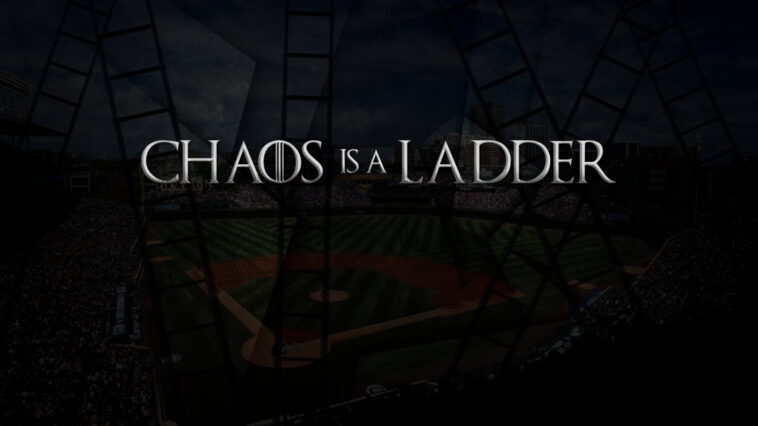Chaos. It seems to be the word that routinely comes up when we are discussing the upcoming MLB season. The 60 game short season sprint that will be the baseball season has definitely tested the allegiance of baseball fans and fantasy baseball players alike, and will continue to do so. I am not here to tell you which side to be on. Thats up for you to decide. I love baseball and everything about it so I am excited for the chance to watch it this season as always. I also will not be the guy calling for David Price’s head because he is opting out of playing this year. If I had enough money to not have to go to work amidst the pandemic, I would too. If you are mad that someone paid him a lot of money to play baseball, do not take it out on him and use your energy for something good in your life.
Chaos is a ladder. If you are familiar with the hit TV show Game Of Thrones, you are most likely familiar with this line spoken by the shows often whistle blower/chaos starter Lord Peter Baelish, aka Littlefinger. His point that he was trying to hammer across was that among all the fighting and chaos in the realm, that this was an opportunity for someone to emerge with a better standing in the hierarchy of Kings and Queens versus the less noble (whom he was). Use the chaos as a way to position yourself that is beneficial to your well being. Using this concept, I will explain what I am using as my steps to climb the fantasy baseball ladder among all the chaos the short season is expected to and most likely bring. In short, among the chaos is a rush to determine what player trends will better help you to find an edge this year. My strategy is….well, the same as it’s ever been. To roster a team of players with skill sets that I believe prove valuable to my fantasy baseball team, in the best way I can and limit the amount of risk I am rostering. With more chaos around me, I am choosing to reduce the noise and stick to basics.
To better help understand my thinking about the upcoming season, I will guide you down a small path of my fantasy baseball mind and how I like to evaluate players and construct my rosters. I love stats. I love the analytical breakdown of players. Ever since I first laid hands on the Baseball Forecaster from BaseballHQ I was head over heels about the ability to decipher how a player’s skills and subset of skills can show me more about a player than his surface stats. In the past 3 years it has been even more fun incorporating Statcast data into our evaluations of players for fantasy purposes, as well as learning more about the game of baseball in it’s own right. I try everyday to learn and absorb as much information as I can from the countless wealth of stats, live games, and watching video (specifically on prospects).
One thing I have chosen to do is limit the amount of “noise” I include in my player evaluations. While I have taken the time to understand as many metrics and stats as I can, I have chosen to bring only a select few to my primary core of evaluations. The others can stay in the background, and I may peak at them from time to time, but to me they exist as noise and “fun” to look at. My reasoning is that there is obvious proof that we are not really good at accurately predicting player performance, so why are we trying to add more subjects to possibly be wrong in? Why “bake” in more possible performance projectors for this season because of the shorter season? If you were short on time and you were baking a cake or cooking a meal, would you all of a sudden start looking for more ingredients to add, despite probably knowing what would make a good tasting cake or meal already from prior experience? I know I would not. I will go through various new trends in the market that attempt to predict player performance/value in the short season, as well as possible roster construction approaches, and how much I will be “baking” or not “baking” the trends into my strategy for the year.
NL PITCHERS NOW FACING DH’S AND NOT PITCHERS :
| 2017-2019 | BA | OBP | SLG | OPS |
| NL PITCHERS | .124 | .155 | .160 | .315 |
| AL DH | .252 | .329 | .453 | .782 |
The above chart shows how National League pitchers fared at the plate the past three seasons, as well as the American League designated hitters. Needless to say, NL pitchers will now have a harder time doing their job as they are normally accustomed to. The edge we used to give to NL pitchers versus their AL counterparts has vanished. I am still going to have trust in the better NL pitchers to adjust to the different level lineup long competition. Players will always remain more than stat adjustments we make because of new rules in game play from the MLB. Jacob deGrom has had a 2.28 ERA with 40 K’s over the last two years versus American League teams playing with the DH. He also struck out 35 of the 50 pitchers that came to bat against him last year. The Pull Hitter approach to this is bake it in a little bit with guys like deGrom, Strasburg, Kershaw, Flaherty, Castillo, Greinke. Half bake it with guys like Bauer, Paddock, Hendricks, Bumgarner all the way down to your Musgrove/Stroman type ADP targets. Stroman is a a guy I like because he has shown he can be effective in the AL. Fully bake the adjustment in for NL pitchers after the 220-ish range in ADP.
NL LINEUPS ADDING THE DH:
For the 2020 season, and possibly beyond, the DH will find its home into the National League for every game played. This opens up some at-bats for players in many ways. Super utility guys will be on the field as much as they can handle, subbing in for players who will slide into the DH spot as “semi-off” days. I do not think you will see clubs using one guy as their DH. Last year, 8 players had 400 or more at-bats primarily at DH. Pro-active and progressive coaches are using the DH spot as a way to keep your better bats in the lineup, but give them a rest on the field. Some players will benefit from playing the field even less now. Guys who are injury-prone or are on the path to healing from an injury earlier in the year will now have the opportunity to transition into the season more seamlessly. The DH helps teams with a plethora of skilled players fighting for playing time at positions. The Reds are a team that will clearly benefit by being able to keep a constant wave of bats ready for both righty and lefty pitchers. Bump up Winker, Akiyama (especially for possible lead off) and even Eugenio Suarez as he is recovering from off-season surgery. the Dodgers will be another team that will be able to employ a constant cycle of position players and DH’s into their lineup. Guys like AJ Pollock would benefit from not having to run around in the field, and Kike Hernandez has a chance to play everyday because of his ability to play almost every position. In deep leagues, or maybe draft and holds I am rostering Matt Beaty for his multi positional eligibility and ability to hit. The Pull Hitter approach here is to bump up guys like Braun, McCutcheon, Howie Kendrick, JD Davis, Will Myers, Kevin Cron and Tommy Edman. I love Edman’s ability to help in multi-categories as well as multi-positions. Is there a name for guys like that? A multi cate-positional player? MCPP?
STAT TREND – 60 GAME STATS:
Rolling graphs are great to look at. It shows a snapshot of skills or raw numbers in a quick snapshot view, and who does not love snapshot views of data? I find it most beneficial in looking at a pitchers velocity, pitch mix, and first pitch strike rates on rolling graphs. For batters I will look at wOBA, as well as hard hit fly balls and line drives. I see lots of info on the numbers certain players have been able to run off in 60 game stretches. I will admit that it is tons of fun to glance at what an individual can accomplish in subsets of 60 games, but I will not use it as tool to determine any conclusion on who is most likely to have “hot” or “cold” stretches in this 60 game sprint. Pull Hitter verdict: not baking 60 game subsets at all into the roster construction process.
“COMPILERS”
Theres a notion out there in the fantasy world that batters who earn their value through accumulating at-bats will somehow lose value. I do not see this at all. I want to beat variance with volume. The stats they “compile” do not just appear magically in games 61-162. We need batters who will be in the lineup near everyday, preferably toward the top of the order, and with a good history of staying healthy and racking up at bats. The Pull Hitter approach here is to not bake this anti-compiler tag at all into the player evaluation.
PITCHING ADP ON THE RISE :
Recent draft results from the drafts being held on NFC show that starters and closers will come at a hefty price on draft day. The top line pitchers, your “aces” and “studs”, are climbing up the board. If you are looking to get deGrom or Cole, you are in the first round. It is guys like Bieber, Clevinger, Kershaw, Giolito and Darvish who have seen some dramatic bumps. One that is too far beyond my reach. Im not saying its a bad strategy or a bad pick to go up and get these guys, it is just something I will not practice in my roster construction. Ramp up for the pitchers will put them behind the eight ball in getting ramped up to go deep in games- not for all pitchers. I am not comfortable passing up bats who play everyday versus a pitcher who might be giving you less innings pitched out the gate. I am looking to grab some innings eaters who look like they will be ready to throw 6 innings in their first start. The Pull Hitter approach is to start off with a Greinke/Lynn combo at starting pitching and pound your reliable bats early. Reliable inning eaters who will be full go come the start of the season.
Closers have also seen a tremendous spike in their ADP. Keone Kela and Joe Jimenez are now going around the time where you can usually start settling into some great mid round power. If you are late to the party, you will be passing on Kyle Schwarber, Carlos Santana and Elvis Andrus to draft Archie Bradley, Kela and Jimenez. I am not getting involved with that in any fashion. Nor do I really want to go into rounds 6/7 and grab Ken Giles and Nick Anderson. Coaches have less time to be patient with closers. Everyone is in the playoff race and I expect clubs to try to sneak into the playoffs and content for a World Series. You can grab a closer like Aroldis Chapman, but I will present this scenario to you. He struggles a little bit and the Yankees reach into their excellent bullpen to replace him. It is possible, specifically given the Yankee’s desire to win and the fact they do have other great options. Here is another scenario. Liam Hendricks is projected for 25 IP, and a 2.95 ERA. If he gives up 3 more ER in those 25 innings pitched, your are looking at a 3.96 ERA. Yeh, exactly. The small output in IP from your relievers can swing those rate stats wildly. Too much for me to get involved with so early. I am baking in this trend of getting closers early by waiting to draft them as late as I can. If the opportunity arises in that I can get a Giles or Neris at a more reasonable acquisition cost I am all in. I will try to target one backend guy like Gallegos in case he runs with the job, and if he doesn’t, he will still provide good ratios. I honestly believe Carlos Martinez will find himself closing again this year. When I am extreme Pull Hitting I usually tend to wait on closers, and try my hand in some speculative bids on next up relievers who have tantalizing skills.
Which brings us to the “piggyback” starters/bulk relievers that might be a common place strategy for some teams. The Atlanta Braves have led the charge by saying their pitchers will start for about 2-4 innings then get piggybacked by another 2-4 inning outing. There is some real value to be had here. These pitchers will have the chance to get wins in relief and hopefully put up stellar pitching lines along the way. Pay attention to the intra squad scrimmages and team depth charts. As of now I am targeting Fredy Peralta, Matt Andriese, Ryan Yarborough, Yonny Chirinos, Bryan Abreu, Randy Dobnak, Ross Stripling, Tyler Mahle, Andrew Kittridge and Trevor Richards. They have experience starting and relieving and can be extremely valuable to your team at the right moments.
These are my first impressions in the re-start of the Fantasy Baseball draft season in 2020.



